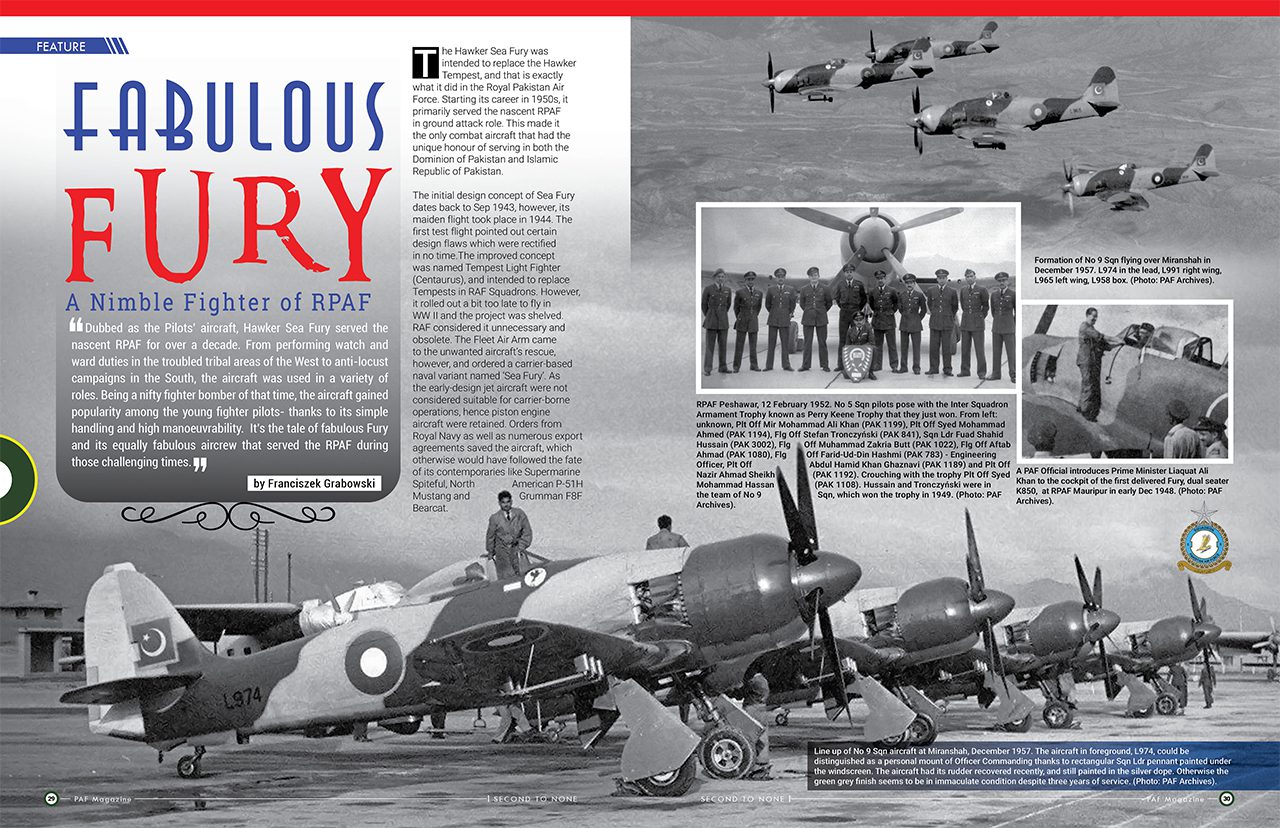Dubbed as the Pilots’ aircraft, Hawker Sea Fury served the nascent RPAF for over a decade. From performing watch and ward duties in the troubled tribal areas of the West to anti-locust campaigns in the South, the aircraft was used in a variety of roles. Being a nifty fighter bomber of that time, the aircraft gained popularity among the young fighter pilots- thanks to its simple handling and high manoeuvrability. It’s the tale of fabulous Fury and its equally fabulous aircrew that served the RPAF during those challenging times.
The Hawker Sea Fury was intended to replace the Hawker Tempest, and that is exactly what it did in the Royal Pakistan Air Force. Starting its career in 1950s, it primarily served the nascent RPAF in ground attack role. This made it the only combat aircraft that had the unique honour of serving in both the Dominion of Pakistan and Islamic Republic of Pakistan.
The initial design concept of Sea Fury dates back to Sep 1943, however, its maiden flight took place in 1944. The first test flight pointed out certain design flaws which were rectified in no time.The improved concept was named Tempest Light Fighter (Centaurus), and intended to replace Tempests in RAF Squadrons. However, it rolled out a bit too late to fly in WW II and the project was shelved. RAF considered it unnecessary and obsolete. The Fleet Air Arm came to the unwanted aircraft’s rescue, however, and ordered a carrier-based naval variant named ‘Sea Fury’. As the early-design jet aircraft were not considered suitable for carrier-borne operations, hence piston engine aircraft were retained. Orders from Royal Navy as well as numerous export agreements saved the aircraft, which otherwise would have followed the fate of its contemporaries like Supermarine Spiteful, North American P-51H Mustang and Grumman F8F Bearcat.
The Design
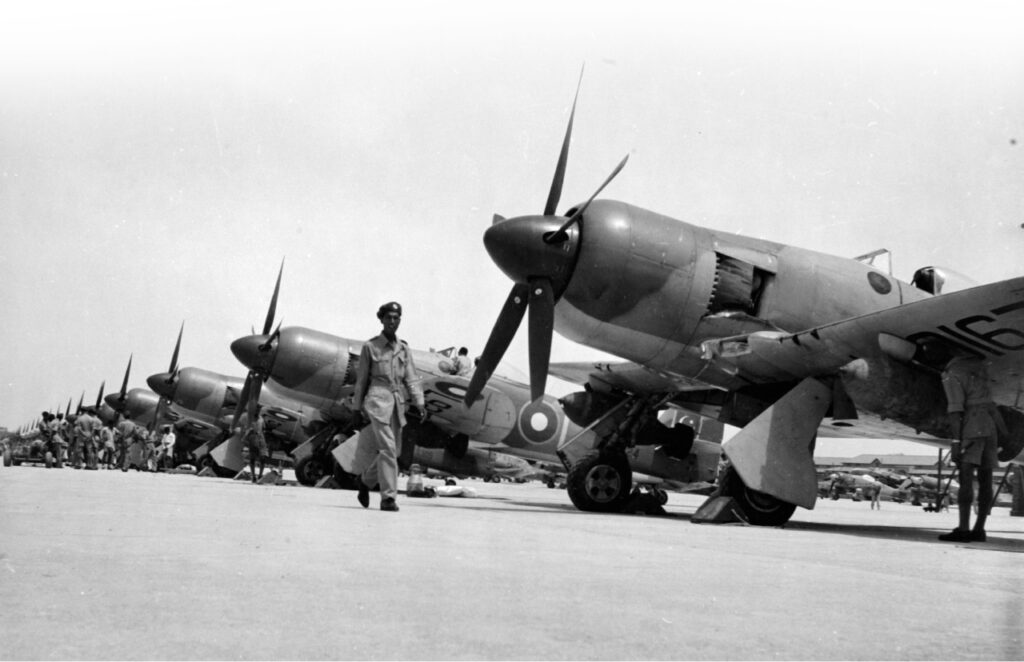
The Sea Fury was a modified aircraft, navalized to give it the capability of operating from aircraft carriers. The design evolved from the Hawker aircraft, most notably the Tempest. An example of its heritage was evident in its partially elliptical wings and fuselage, a feature directly lifted from the Tempest. However, the fact that the wings had more strength to withstand the excessive force of landing on an aircraft carrier, marked its superiority over the Tempest. While being lighter in weight and volume, the Sea Fury boasted much higher speed and power. This makes it the last and the fastest of the Hawker engine lineage.
When it comes to pitting heads amongst the two aircraft, there is no competition. The Sea Fury wins by a long shot. The Sea Fury possesses double the velocity and climb rate, and this while being equipped with much heavier equipment and substantially longer range. It could accelerate to an impressive speed of 460 mph and could climb to a height of 20, 000 feet in less than 5 minutes.
The Fury featured the Bristol Centaurus reciprocating engine, which operated with a five-bladed propeller. The Centaurus engine distinguished itself from other engines by the fact that several of its subsystems were electrical and were run by a generator backed by two independent batteries.
Fury in Pakistan
Pakistan’s decision to acquire Sea Furies was made in late 1947. The initial interest was in an advanced trainer for conversion onto Tempest fighters. The high-performance Tempests were often hard to handle by pilots whose experience was limited to Harvard advanced trainers. Therefore, a single dual-seat Sea Fury was acquired for operational testing to determine if the aircraft could help overcome this inconvenience. The aircraft was delivered to Pakistan on 3 November 1948 with the serial K850. It was easily distinguishable from the earlier aircraft by distinctive separate teardrop canopies over instructor and pupil cockpits.
The tests produced promising results, and the decision was made to sign a contract for Sea Furies F60s and Sea Furies T61s in 1948.
The original requirement dictated by PAF had three Fighter Bomber squadrons, each of which would compromise 8 aircraft, with 22 Sea Furies to be held in reserve. The conversion squadron was to be equipped with three dual and two single cockpit Sea Furies. The conversion squadron were supposed to have four aircraft in reserve. This brought the total to 55 aircraft. However, the contract made brought in 52 aircraft in total. The small difference in the number was owed to budget constraints at the time.
The ordered aircraft started to arrive in the autumn of 1949, with FB-60s L900 to L925 (serial nos) being delivered until the end of the same year. The next year L926 to L949 as well as T61 trainers K851 to K854 were delivered. Those aircraft also wore standard desert scheme livery as in the case of previously delivered Sea Furies.
Integrating the Fury in RPAF
Once all aircraft made to Pakistan, the re-equipment process commenced. No 9 Sqn was the first unit to be converted on the new aircraft in July 1950. The markings used were identical to those used on Tempests – Desert Scheme, standard glossy national insignia, and black serial numbers on tail and under surfaces. Spinners were repainted in squadron colours: No 5 – blue, No 9 – red, No 14 – presumably white. Individual code letters tied to pilot name’s initials were painted on the fuselage roundel in white, no codes on lower cowling. Additionally, squadron emblems painted just in front of windscreens for the first time. Shields were painted in the squadron colour. Emblems of No 5 and No 14 Sqn were likely painted in black, while Dragon of No 9 Sqn possibly in red.
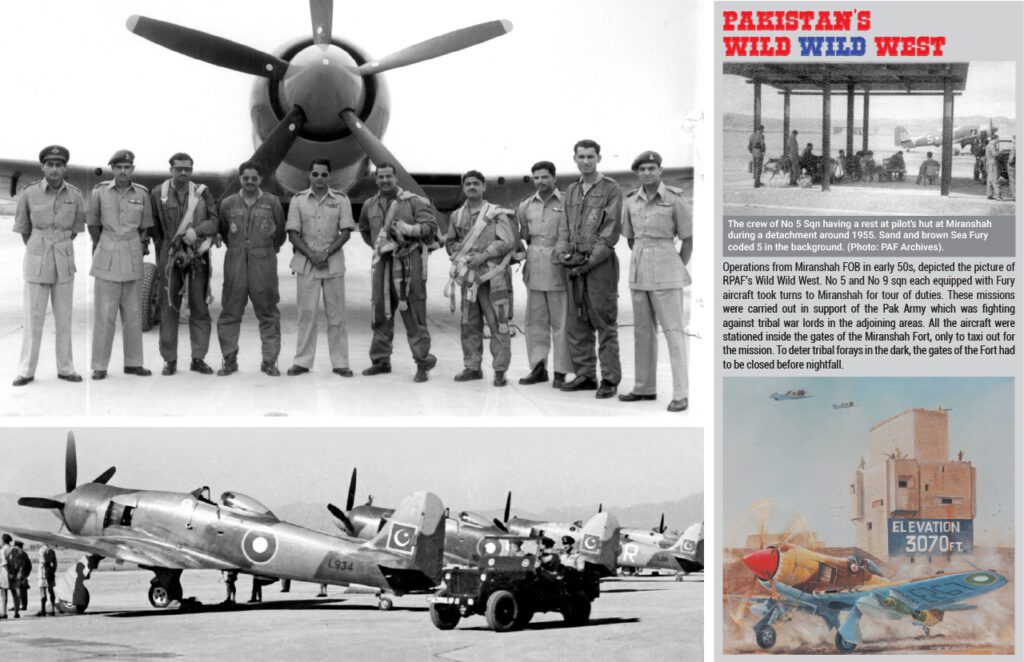
Expanding the Fighter Bomber Wing was quite an effort. The strict requirement was that each operational aircraft needed ground crew made up of 10 personnel, while unarmed training aircraft of the conversion squadron required team of seven ground crew. The expansion was executed in parallel, as both Sea Fury and Tempest aircraft were considered interchangeable. Tempests were to be held in reserve until superseded by Sea Furies. At the time policy for pilots’ training called for two years at the RPAF College, Risalpur, with the last six months allotted for conversion training on Fury/Tempest aircraft. The conversion was obligatory for all pilots. Sea Furies offered another substantial advantage over the Tempests. The aircraft had the provision for a reconnaissance camera, so it was possible to use it for reconnaissance without any modifications, once the camera was installed. This made Fury the first multi-role combat aircraft of PAF.
Before the Pakistan Independence Day celebrations of 1950, all three Squadrons were converted on fury and displayed their new planes at the RPAF Mauripur during the ceremony. It seems that despite better handling, Sea Fury was still a demanding aircraft, and perhaps too tempting to fly it to the limits. The aircraft claimed the lives of several experienced officers during initial years of service with RPAF, which led to shortfall in the availability of aircraft. Due to a shortage of Sea Furies a desperate step was taken and No 9 Sqn converted back to Tempests in November 1950. Simultaneously, another batch of Sea Furies was immediately acquired in 1950. The 24 aircraft were taken from the FAA order which was in production at the time, and converted to de-navalised standard according to the RPAF specification. They were delivered between late January and July of the next year. They received serial numbers L950-L973, and looked like the previous batch.
The Red Dragons
Meanwhile, Sqn Ldr Zafar Ahmad Chaudhry (PAK 3095) Officer Commanding of No 9 Sqn, formed an aerobatics team. He was inspired by the show of ‘Blue Angels’ of the US Navy which he had seen in Florida in 1949, while supervising RPAF cadets training there. The team started training in the winter of 1951, still on Tempest aircraft. When the Squadron received Sea Furies in February 1951, the team continued training on the new aircraft accordingly.
The team was named ‘Red Dragons’, after the colour of the squadron and the emblem on its shield, also used as a call sign. Red Dragons had its debut on 2 May 1951, during the farewell ceremonies for AVM R.L.R. Atcherely. The first team consisted of Sqn Ldr Zafar Ahmad Chaudhry (PAK 3095) – right wing, Flt Lt Syed Muhammad ‘Boss’ Ahmad (PAK 2880) – reserve, Flg Off Saeed Ullah Khan (PAK 3241) – left wing, Plt Off Trevor Harold Gotting (PAK 802) – lead, and Plt Off Frederick Alan ‘Fred’ Isaacs (PAK 981) box. This was the first display team of the RPAF and rose to fame in national/ international media in no time.
Perhaps the only person who flew the Hawker Fury to its maximum limits in RPAF was the famous solo aerobatics pilot of PAF, the legendary Air Cdre FS Hussain-affectionately known in PAF as ‘The Prince of Pilots’.
During his hey days, Flt Lt FS Hussain gained mastery over this aircraft and rose to fame at national and international levels with his signature eight point inverted slow role manoeuvre.
In November, 1951 Sqn Ldr FS Hussain, took over No 5 Squadron from Sqn Ldr Żuromski. The squadron excelled tremendously under his professional command and won many laurels. He led the unit for the second shooting competition of RPAF. On 12 February 1952, the Commander-in-Chief Air Vice Marshal L. W. Cannon presented the Perry Keene Inter Squadron Armament Trophy to his squadron. It is interesting to note, that FS Hussain and Flg Off Stefan Tronczyński were both winners of the first Perry Keene Trophy, held back in 1949.
In Combat Roles
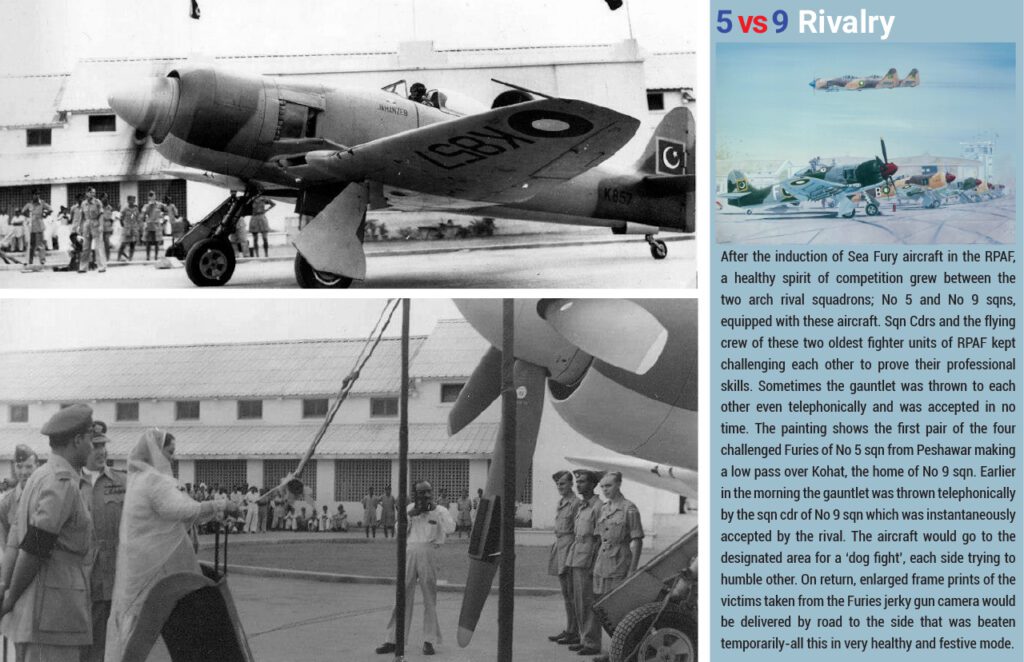
Sea Furies continued training the young pilots in variety of roles including ground attack, air combat, formation flying etc. In Sep 1950, No 5 Sqn transferred to Miranshah to take up its duty. The Sea Furies saw some intense flying there, providing necessary reconnaissance and support, as well as continuing combat training including live firing and bombing. The latter role was considered a power demonstration for the insurgents watching the fort and necessary to counter Faqir of Ipi’s rebellion as well as incursions from Afghan territory. These transfers were much liked by Fury pilots, as they broke the monotony, and allowed to escape the daily drill at the permanent stations. At Miranshah, Furies were dragged within the fort boundaries at night, and pilots could enjoy local cuisine as well as watch films in a makeshift cinema.
It was at this time that multiple changes in markings of the Furys took place. Squadron emblems were painted with white background. Black and white photos cannot determine with certainty if the emblems were painted in black or in squadron colours. Also, code letters started to be applied on white rectangular section on the lower cowling, just like on Tempests.
Around this time another tragically bizarre incident came to pass. On 4 June 1953 Plt Off Syed Enver Ali Mirza (PAK 1355) was killed in a Sea Fury. He was the son of Iskander Ali Mirza, the first Defence Secretary in the Liaquat Ali Khan’s government. As Defence Secretary, he was closely involved in the purchase of the Sea Furies, one of which later consumed the life of his beloved son. Iskander Ali Mirza would go on to become the first President of Pakistan.
Several Sea Furies had been lost to accidents by this time. So, to supplement the losses, further 18 aircraft were ordered. By the end of 1953 eight aircraft were delivered with serial numbers L974-L981, and the remaining ten numbered L982-L991 arrived the next year. The last Sea Fury delivered was a dual seater K858 which arrived in 1955. They were painted in a new RAF Day Fighters Long Range and Day Intruders Scheme consisting Dark Green and Dark Sea Grey disruptive pattern with Blue under-surfaces. The previously acquired aircraft were gradually repainted in the scheme as well. It is easily distinguishable on B&W photos by reversing the order of darker and lighter shade of the camouflage, darker under surfaces and less careful demarcation lines.
The scheme was not the only change. Around the time of arrival of the new aircraft in 1954, code letters identifying each aircraft were replaced with numbers. Additionally, Squadron pennants started to appear on the aircraft. This followed a RAF custom from inter-wars years, originating from WWI, when actual pennants were used to denote leading aircraft.
In April 1954, King Saud visited Pakistan and was flown out for an inspection of RPAF Base Peshawar. An appropriate air display was arranged for the King. The following month, a firepower demonstration was performed at Fort Sandeman by No 14 Sqn on their Furies. On 15 August 1954, a yearly air display took place in Karachi to celebrate Pakistan Independence Day. As every year, Fighter Bomber Wing arrived from Peshawar for the celebrations. In November same year, Fighter Bomber Wing was engaged in military exercise appropriately named ‘November Handicap’. This was the very first large-scale Air Force and Army Air Cooperation exercise. It was held at RPAF Station Chaklala, Murid Airfield and land areas north of Jhelum River. All available RPAF aircraft including Attackers, Sea Furies, Harvards and Freighters of No 6 ‘Multi Role Transport’ and Bomber squadrons were involved. Such scenarios like attack of Fighter Bomber Wing on ground bases were practised. Attackers were to intercept the hostile force based on Mobile Observer Units’ signals, due to the absence of ground radars at that time.
In May 1955 No 14 Sqn took part in a summer camp at Samungli. During October and November 1955, No 14 Sqn took its shift for a tour at Fort Miranshah. As 1955 came to an end, 1956 brought many changes for the Sea Fury.
The Swan Song of Fury
In 1956, the long-negotiated agreement with the USA resulted in the arrival of F-86 Sabre fighter jets. It was the beginning of new era of jet dominance and brought many changes in flying and ground handling procedures in RPAF. New organisation schemes were prepared, flying discipline was tightened and flight time increased. These changes coincided with Pakistan becoming a Republic on 23 March 1956.
With the deliveries of F-86 Sabres, a gradual conversion process had started. In January 1956, No 11 Sqn bid farewell to their Supermarine Attackers and the personnel proceeded for courses that were to train them to handle Sabres. Then, Sea Fury Squadrons began conversion. No 5 Sqn did so in March 1956. Sabres built specifically for Pakistan started to arrive in June 1956.
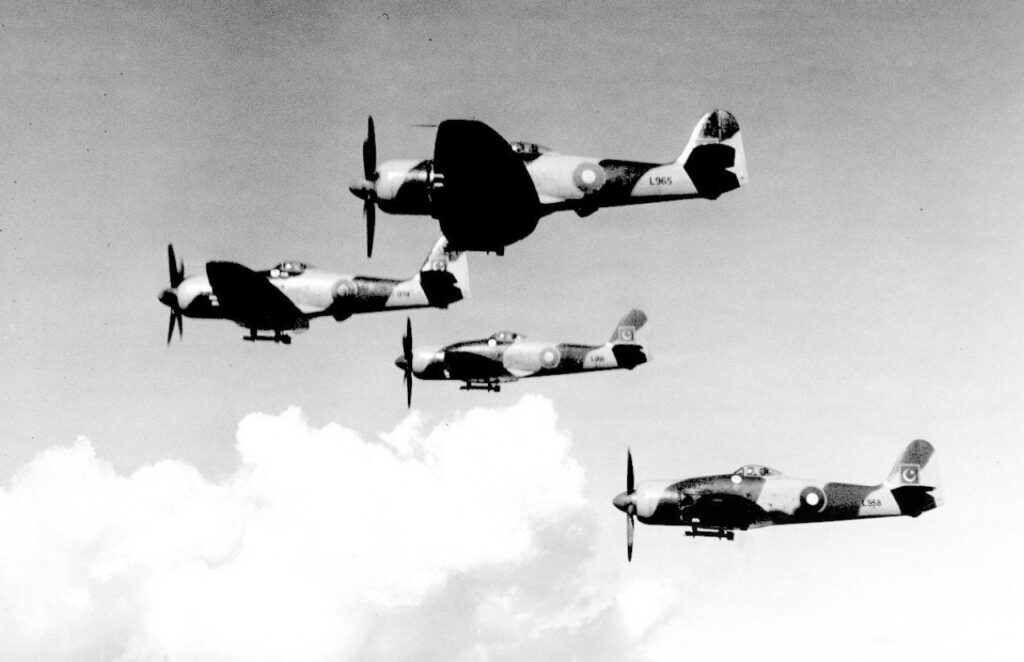
Much to disappointment of its pilots, No 9 Sqn retained Sea Furies. Apart of No 9 Sqn, few Furies were assigned to Target Towing Flight of No 12 (Composite) Sqn. The introduction of the type was supervised by the new commander of the Flight, Flt Lt Nisar ul Haq (PAK 1245), who had previously flown Sea Furies in No 5 Sqn back in 1952-53. These aircraft towed drogue targets for other aircraft and anti-aircraft artillery and were also used in calibration of radars and other national emergency duties. The aircraft retained their green-grey camouflage, but the under-surfaces were painted in distinctive yellow and black striped pattern, to make them visible to ground observers.
Furies moved to Kohat in November 1956 to make room for Sabre Squadrons coming in large numbers. Detachments to Miranshah were continued throughout. It was during one such detachment in December 1957, when the Squadron was visited by the famous British reporter John Fricker. A perfect show of ground strafing and rocket firing on Sea Furies was arranged and it deeply impressed the British guest, well known for his praise for PAF. Another impressed visitor was Lt. Gen. Axel Georg Ljungdahl, Chief of the Royal Swedish Air Force, accompanied by his wife Ruth, who visited No 9 Sqn at Miranshah, the same year.
In September 1959, Furies were used in fighting insurgents in the Bajaur area, intruding from Afghanistan. This was last of the actions the Furies saw in No 9 Sqn. In March 1961, No 9 Sqn finally retired their Furies being selected for conversion on supersonic F-104 Starfighters.
At the same time, No 23 Sqn was established at PAF Kohat, on 16 March 1961. Initially, the sqn borrowed some aircraft and the personnel of No 9 Sqn for operations and continued service in NWFP. The Squadron continued close support for the army with the additional responsibility of carrying out anti-locust operations in South, whenever required. It was also considered a unit providing flying roles to pilots near the end of their commissions and who were found not suitable for jet or helicopter conversions.
In May 1961, the No 23 squadron participated in operations in the Dir-Bajaur area. From 21 to 24, and on 31 May the Squadron was called upon to provide close support and to destroy specified targets in the Bajaur valley. A total of 23 sorties were flown and 60 lbs rockets and 20 mm ammunition were used. Later in the same year, possibly the last fatality involving Sea Fury occurred. On 2 September 1961 Flg Off Syed Arif Ali Hasni (PAK 3684) crashed in poor weather near Fatehjang. On 16 and 17 November 1961, No 23 Sqn participated in exercise ‘Hastings’ flying five sorties.
Later in the year three or four aircraft were flown to PAF Drigh Road for anti-locust operations in Sind. Sea Furies were flown as reconnaissance aircraft locating locust swarms and then directing spray-fitted Freighters onto them. The operation was a big success. No 23 Sqn flew a total of 28 missions between 21 and 30 November 1961. On 23 March 1963, a pair of Sea Furies carried out a flypast over Miranshah Fort during the Republic Day parade of Tochi Scouts.
This actually was the swan song of the aircraft. Sturdy and manoeuvrable Sea Furies were preferred during typical counter-insurgency (COIN) missions over fast jets. They were able to deliver precise attacks, and were easier to handle on low level owing to their slower speed. Lack of aircraft spares restricted their operations, otherwise they would have remained in service for much longer time.
Towards the beginning of 1960s, wear and lack of spares sealed the fate of Sea Furies. No 23 Squadron was number-plated on 4 March 1964, nearly three years after its establishment. The last surviving aircraft continued to serve in variety of roles, but ultimately all the aircraft were retired in 1964. Unfortunately, neither of them was preserved for PAF Museum. Fury never saw real action in the shape of full fledge war, however, it played an important role in fighter training of the earlier generation of RPAF pilots who later proved their mettle in subsequent wars against India in 1965 and 1971. Given a chance, its veterans and present day pilots alike would love to fly this fabulous aircraft cherishing its never diminishing legacy
